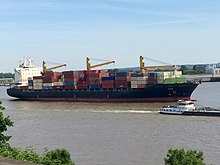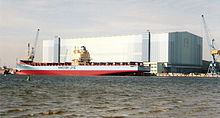Container ship
![]()
This article is about overseas container ships. For feeder container ships, see feeder ship.
A container ship is a type of ship designed to carry ISO containers.
The cargo capacity of container ships is expressed in TEU (Twenty-foot Equivalent Units, cf. tonnage) and corresponds to the number of 20-foot containers that can be loaded. 40-foot containers (measured in FEU, as in Forty-foot Equivalent Unit) are also common, as have 45-, 48- and 53-foot containers since the mid-1990s and the less common 30-foot containers, which have to be loaded on deck, however, as the cell guides (vertical guide rails) are only designed for 40-foot containers. For very large or heavy general cargoes, there are also flat racks, open-top containers or platforms which can be loaded together with standard containers.
Up to a cargo capacity of 3400 TEU, container ships partly have their own loading gear; ships with higher capacities require corresponding superstructure in the port for container handling. These are usually container gantry cranes at container terminals. The trend towards ever larger container ships is leading to an increasing concentration of possible ports of call for container ships at a relatively small number of central container ports, through which a large proportion of maritime trade passes. These ports become hubs; smaller container ships, e.g. feeder ships, travel to and from them (see also transhipment problem - an optimisation problem from the field of logistics).

Container ship on the Elbe in Hamburg
.jpg)
Container ship NYK Virgo on the river Elbe
History
The container ship was built in the United States in the 1950s. The Clifford J. Rogers, which entered service in 1955 with still very small containers, was followed in 1956 by the converted tanker Ideal X owned by the freight forwarder Malcolm McLean. The latter began to transport the semi-trailer bodies of semi-trailers without chassis over longer sea routes by ship. In 1960 McLean founded the shipping company Sea-Land Corporation. As early as the first half of the 1960s, newbuildings planned as semi-container ships were built, such as the Tobias Mærsk, which entered service in 1963. In 1964, the Kooringa, the first newbuilding planned as a full-container ship for ISO containers, was put into service in Australia.
The ships are arranged in such a way that containers are stacked lengthwise to the ship's axis in loading bays or on deck. Cellguides are vertical rails used to guide and secure containers. A cell will fit exactly one stack of 40-foot containers. If a space is used with two 20-foot containers placed lengthwise against each other, this pair is connected at the joint with screw fittings.
By the mid-1960s, there were already 171 container ships in the United States (almost all of them converted, however). In 1966, the container ship Fairland of the Sea-Land shipping company arrived in Bremen for the first time in Germany. As early as 31 July 1968, 102 semi- or full-container ships had been ordered or were under construction worldwide. From 1968 onwards, the conversion of the most important liner services to container traffic began, initially in the North Atlantic trade (between USA/East Coast and Western Europe), and from October 1968 onwards the transpacific service between Japan-USA/West Coast. Here the NYK Line used the Hakone Maru. At the end of 1968, the first container ships (750 TEU each) were built in Germany by Bremer Vulkan with the Weser Express for Norddeutscher Lloyd and by Blohm + Voss, Hamburg, with the Elbe Express for HAPAG. They entered service on the North Atlantic route with their sister ships the Rhine Express and the Mosel Express. Also in 1968, the Hamburg shipping company August Bolten deployed another full container ship under the German flag, the Bärbel Bolten (140 TEU).
On July 1, 1970, the worldwide fleet of semi and full container ships amounted to 201 units (of which 154 were full container ships); the following year, the fleet of full container ships totaled 231 units. In 1969, the Europe-Australia/New Zealand liner service was converted to container traffic, followed by Europe-Far East at the end of 1971, Europe-South Africa and Europe-Caribbean/Gulf of Mexico in May 1977. The South Africa-Far East route (safari service) followed in 1981. This completed the conversion of the most important liner services to container traffic.
In 1984, the shipping company United States Lines offered an eastbound Round the World Service for the first time. This service, operated with twelve ships of the American New York class, ended after six months with the bankruptcy of the shipping company. A service launched in the same year by Evergreen Marine from Taiwan via the Panama Canal and Suez Canal with twelve ships in each direction was abandoned around 1999, as a scheduled service from point A to B is more efficient. In the 1990s, the German Senator Lines also started a Round the World Service, but discontinued it in favour of a Pendulum Service.
Container dimensions of 20 or 40 ft length, 8 ft width and 8 ft 6 in height have become internationally established. The old container dimension of 35 ft introduced by Sea Land has been discontinued; instead, 40-ft and 45-ft high-cube containers are increasingly being used today, as are 53-ft containers within the USA, since longer articulated trucks are permitted there than in Europe.
In early 2020, freight rates had plummeted due to the impact of the Covid 19 pandemic on the global economy, a container from China to Europe cost only around $800 instead of $1000 before, ships with a total capacity of 2.4 million standard containers (TEU) were temporarily idle as trailers. However, as early as August 2020, global shipping traffic picked up significantly, and the size of the idle fleet fell to less than one million TEU.
The fourth quarter of 2020 saw a real boom in container shipping. The number of new orders for HMM Megamax-class vessels reached the highest level since the third quarter of 2015, with a total capacity of 673,500 TEU. For the period up to 2024, DHL expects annual growth rates in global container traffic of between three and four percent, with traffic from Asia to Europe predicted to increase by 3.7% and from Asia to North America by 3.9%. Freight rates from Shanghai to Hamburg and Los Angeles have literally exploded in January 2021, up to $9520 per container, shipping line revenues and profits are up hugely in 2020 compared to 2019, 82% for Hapag-Lloyd, 181% for Maersk, 803% for CMA CGM.
According to the statistical surveys of the industry service Alphaliner, 6220 container ships with a cargo capacity of 24.35 million TEU were in operation worldwide in February 2021. According to the survey, the largest three shipping companies by market share were A. P. Møller-Mærsk (16.9%), Mediterranean Shipping Company (15.9%) and the COSCO Group (12.5%). The largest German company is Hapag-Lloyd in fifth place with 7.2%.
See also: Container transport
Side view of the Ideal X
_1979_-_geograph.org.uk_-_812843.jpg)
First generation container ship, Manchester Concord
.jpg)
1970 general cargo vessel American Alliance converted into a container ship
Shipyards
Large container ships of over 7000 TEU were built at the following shipyards, among others:
Europe
Odense Staalskibsværft (Odense Steel Shipyard), Denmark (closed in 2012)
East Asia
- Hyundai Heavy Industries, Ulsan/South Korea
- Hyundai Heavy Industries, Samho Yard
- Samsung Heavy Industries, Koje Island/South Korea
- Daewoo Shipbuilding & Marine Engineering
- Doosan, Okpo Yard/South Korea
- Hanjin Heavy Industries, Busan/South Korea
- IHI, Kure/Japan
- Imabari Zōsen, Marugame/Japan
- Imabari Zōsen, Saijō/Japan
- Imabari Zōsen, Mihara/Japan
- Mitsubishi Heavy Industries, Kōbe/Japan
- Mitsubishi Heavy Industries, Nagasaki/Japan
- Kawasaki Heavy Industries, Sakaide/Japan
- China Shipbuilding Corp., Kaoshiung/Taiwan
- Nantong COSCO KHI, Nantong/China
- Hudong Shipyard, Shanghai/China
Container ships from German shipyards
In the initial phase of containerisation from 1968 to 1977, a considerable number of large container ships of the 1st to 3rd generation were built by German shipyards, which were leaders in this sector at the time:
- Blohm + Voss, Hbg. (repair yard and special and naval shipbuilding)
- A.G. Weser, Bremen (bankruptcy in the 1980s)
- Bremer Vulkan, Bremen-Vegesack (last (container) ship built in 1997, then bankrupt)
- Howaldtswerke-Deutsche Werft (HDW), Hamburg-Finkenwerder plant (plant abandoned)
- HDW, Kiel plant (still builds small numbers of container ships now and then)
- Flenderwerft, Lübeck
- North Sea Works, Emden
- Peene shipyard, Wolgast (numerous container ships up to 1800 TEU)
- Meyer shipyard, Papenburg, in 2005 four open-top ships (1600 TEU each) were built - MS Eilbek, MS Reinbek, MS Flottbek and MS Barmbek
- The largest container ships built to date (5 ships) have a capacity of 5468 TEU and were delivered to P&O Nedlloyd by Aker MTW, Wismar and Aker Kvaerner Warnowwerft, Warnemünde in 1999/2000.
The largest container ships currently built at a German shipyard were built at Volkswerft Stralsund, Stralsund, from autumn 2005. The type ship, the Mærsk Boston, was christened on 24 March 2006 and delivered in May 2006. They are of type VWS4000 and measured 294.1 m length a.s.l. and 32.18 m beam with a capacity of 4250 TEU. The propulsion system consists of a Sulzer 12 RTA 96C diesel with 93,400 hp. This achieves a service speed of 29.2 knots, making them the fastest container ships in the world.
Container ships of the size 2500/2700 TEU (type CV 2500/2700) were built by HDW in Kiel, SSW in Bremerhaven, Nordseewerke in Emden, Blohm + Voss in Hamburg, Volkswerft in Stralsund, Aker Werften in Wismar and Rostock-Warnemünde.
For years, the J. J. Sietas shipyard in Hamburg has been a leader in the design and construction of container ships up to 1200 TEU in size (feeder ships). From the beginning of 2006, this shipyard also built larger container ships, the first 1700 TEU ship was delivered with the Safmarine Mbashe. In the meantime, the construction of container ships has been discontinued there. In November 2011, the company had to file for insolvency.

Post-Panamax container vessel P&O Nedlloyd Barentsz (5468 TEU) built 2000 by Kvaerner Warnowwerft (2001)

Mærsk Boston , end of March 2006 in front of Volkswerft Stralsund
Search within the encyclopedia